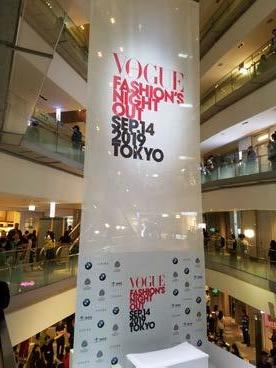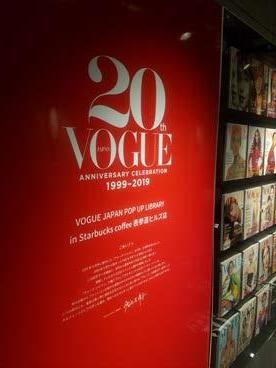
5 minute read
Vouge’s Fashion Night Out by T. Harris
vogue’s fashion night out in tokyo 2019
...Could have been my Night-In
Advertisement
T. Harris (Saitama)
Saturday, September 14 was VOGUE’s 20th Annual Fashion Night Out in Tokyo, held around the Omotesando/Aoyama area. For those who don’t know, VOGUE is a high-fashion magazine that has been around since the late 1800s and is distributed in multiple countries. The magazine is very respected and the fashions it showcases is usually the hottest buzz in the industry. Fashion Night Out (FNO) is VOGUE partnering with different brands to have one night where everyone can enjoy shopping and mingling. This year’s theme was sustainability and environmental responsibility. The event took place in Omotesando Hills, a large mall in Shibuya,Tokyo.
I love paging through VOGUE to get a feel for current trends or what is changing in the fashion industry, so when I read about this event, I had to go. Omotesando is a luxe shopping district in Tokyo, and with VOGUE in town interesting things were sure to be happening. . . .
Or so I thought. I do not want to say that the event was lackluster or poorly done, but I think I had different expectations. In fact, my expectations may have been a little too lofty, and unaware of the actual purpose of the event. I was expecting to see new, interesting, or forwardthinking trends in fashion, but instead walked away with the feeling that FNO was half-heartedly meant to entice people to buy something. Overall, the event, in my humble opinion, lacked sustenance. There were highlights, such as the talk with the VOGUE Japan’s Editor-in-Chief, Mitsuko Watanabe, but overall I left a little disappointed. Here is a rundown of my experience.
FNO is not a showcase event— don’t expect to see new trends.
FNO is not an event that has fashion designers or brands showcasing new collections. I came in expecting there to be a lot of focus on sustainable practices in fashion and new clothes with that in mind. Instead, there was some discussion from panelists, but
not much. There were also T-shirts sold with different images relating to recycling or being environmentally friendly.
Instead, it is more of a brand recognition and building event. Meaning, there were a lot of people distributing ads for different stores, and clerks trying to get you to follow their social media or use their hashtag for a small prize. Prizes ranged from specialty boba teas, candy, or small bags. Some stores did offer new releases that matched the sustainability theme, such as Stella McCartney’s sustainable Hunter boots. The main part of FNO was the interactions with different Japanese celebrities, the VOGUE Japan’s Chief-ineditor, and a performance by Sekai no Owari. The rest of the event was meant to be spent exploring the shops. Which wouldn’t have been a bad thing, but as mentioned, besides maybe ten to fifteen shops, there were not many special events, special edition or new releases being sold, or giveaways occurring.
The crowd was not much different than usual.
If you are the type who loves participating in art events to just people watch, such as me, then FNO may have tickled your itch. In general, Shibuya is a very fashionable area in Tokyo, and Omotesando is a luxury street lined with shops like Gucci, Louis Vuitton, and Valentino to name a few. There is no lack of fashionable people to appreciate on any day of the week. Compared to the average crowd found out and about in Omotesando, FNO did not attract a particularly different crowd to come out. So, if you are big on people watching, you may be better off picking a quiet weekday and enjoying the crowds.
The purpose was confusing.
As I wandered throughout Shibuya and the different roads around Omotesando I became curious as to why VOGUE saw this event as something that had to be done. Through my eyes this was not an event done for the love of fashion or art, but more a chance for brands to increase their social media followers, build up their recognition, and hopefully sell some items. But as I walked around, I noticed that, besides the ten to fifteen stores actively luring people in with small trinkets, the vast majority of stores were empty or almost empty, and it was business as usual for them. The crowd swelled during the build up to the Sekai Owari performance, and then dispersed right after.
For many of these stores, FNO was not helping them attract more attention or sell clothing. In fact, the lack of results (combined with VOGUE’s poor planning) led to FNO’s discontinuation in New York in 2013 and systematic shut down in the US. People came to just look around and have fun, not to buy anything. If anything, I think this event was more for VOGUE’s sake as a way to better establish its own brand voice in Asia. But I wonder how mutually beneficial it is for the small businesses that feel pressured to participate, tolerate the crowds and see no return on investment.
Do I regret venturing out to Tokyo for FNO? No, it gave me a new perspective on the fashion industry and gave me a lot to think about concerning the business aspect of it all. Plus, Shibuya on a Saturday? There are worse places to be. I think if I am to give advice to anyone interested in this event, it would be to stifle your expectations, have a set list of brands you know are participating that are doing something worthwhile, take it easy, and enjoy yourself.
VOGUE’s Fashion Night Out will also be held in Kobe on October 19th, Nagoya on October 26th, and Osaka on November 16th-17th. If you attend one of these events please send in your opinion to the event to CONNECT!
T.Harris is a second year ALT in Saitama. In her free time, she likes to visit museums, watch anime, and browse through fashion magazines.
Photos: T. Harris













